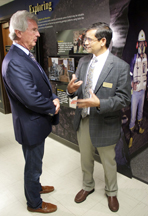Purdue's museum-quality exhibit is a gold mine' for students and teachers
April 29, 2014
 |
|
Bill Reid, from left, and Indrajeet Chaubey, head of the Department of Earth, Atmospheric and Planetary Sciences, stand next to the El Aguila Mine Exhibit at Purdue. The exhibit was made possible by a gift from Reid, an alumnus of the department. (Purdue University photo/Tim Brouk) Download Photo |
WEST LAFAYETTE, Ind. — The new El Aguila Mine Exhibit at Purdue University offers educational nuggets and rich resources for students in grades K-12 and beyond.
The museum-quality interactive display that includes a short hallway made to look like a mine tunnel was dedicated on Tuesday (April 29) on the second floor of the Delon and Elizabeth Hampton Hall of Civil Engineering.
The display takes visitors through the entire mining process and includes a core sample and objects from the El Aguila Mine in Oaxaca, Mexico, which mines several kinds of ore including gold. In addition to floor-to-ceiling wall wraps, four touch-screen displays feature original games, information and videos designed for K-12 students and teachers, including a first-person perspective video of a ride through the mine.
"We hope this display will inspire the next generation of students, scientists and teachers, as it illustrates one of the many subfields within the geosciences," said Indrajeet Chaubey, professor and head of the Department of Earth, Atmospheric and Planetary Sciences (EAPS). "We use the El Aguila Mine Exhibit as a destination to bring students and teachers to our campus so that we can expose them to the various EAPS subdisciplines and introduce students to exciting careers in these fields."
The display was made possible by a $100,000 gift from Bill Reid, an alumnus of the Department of Earth, Atmospheric and Planetary Sciences. Reid, now retired, is the former chief executive officer of Gold Resource Corp., the company that owns El Aguila Mine. In addition to the funding, Reid brought a team from Purdue to the mine to gather information, photos, videos and items for the display.
"I was fortunate that when I was looking around, trying to decide on a career path, the professors in the department brought to life the exciting nature of geology and gave me glimpses into what a career in the field could be," said Reid who earned a bachelor's degree in physics in 1970 and master’s degree in economic geology in 1972. "They were right. It has been an exciting, enjoyable and rewarding career that also contributes to the world’s increasing need for natural resources. Everything we have in a material way at its start is either grown or mined. This display is my way of giving back to Purdue by trying to show current students the important, rewarding and enjoyable life of a geologist."
The team worked with Purdue's Agricultural Communications' Exhibit Design Center to create the display.
The display shows the entire mining process from the geologic processes that form the mineral deposit through exploration and a search for clues of where to find ore deposits, as well as mining safety, mining and processing techniques, and the restoration of the land and environment after mining is complete. Throughout the display different careers in geoscience are presented.
"The exhibit really is unique because it goes beyond just panels and posters as it shows what goes into underground mining operations and the attention that today is paid to the environment and community," said Bill Zinsmeister, professor of earth, atmospheric, and planetary sciences. "In the old days there wasn't much concern given to the environmental impact and that gave the public a negative view of mining, but today there is a focus on sustainably extracting resources and becoming a part of the community in a responsible way."
Since the exhibit opened, Purdue students and visitors pass by it daily and formal viewings are made by middle school classes, Boy Scout and Girl Scout troops and other organizations regularly, said Steven Smith, the K-12 outreach coordinator for the department.
"Kids are amazed and in awe of the exhibit," Smith said. "The idea of mining for gold, which is used for jewelry, medicine, electronics, nanotechnology and space exploration, ignites their natural curiosity. The display grabs their attention and engages them because they get to move things, play games and really interact with it. By the end of a tour I usually get a lot of questions about careers in the geosciences."
The exhibit is a flagship of the department's plans to install thematic wall wrap displays on the second, third and fourth floors of Hampton Hall to illustrate earth, planetary and atmospheric sciences respectively, Chaubey said.
"We want to make Purdue and the department an educational destination for the community," he said. "We want to create long-lasting, visually appealing displays that go beyond hanging a poster or picture on the wall."
Writer: Elizabeth K. Gardner, 765-494-2081, ekgardner@purdue.edu
Sources: Indrajeet Chaubey, 765-494-1162, ichaubey@purdue.edu
Bill Zinsmeister, 765-494-6112, wjzins@purdue.edu
Steven Smith, 765-494-9439, mrsmith@purdue.edu
Related video: https://www.youtube.com/watch?v=CjXx-Gne5wg

